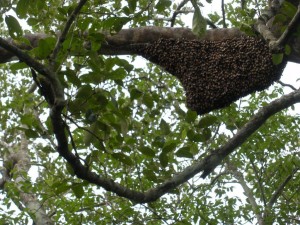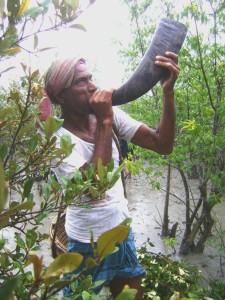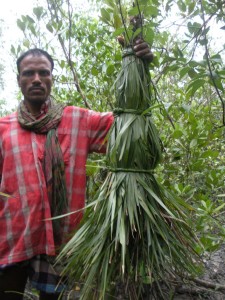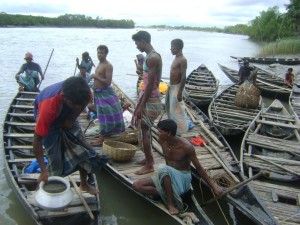Pavel Partha (Translated by Silvanus Lamin)
The Sundarbans is the largest single block of tidal halophytic mangrove forest in the world. The forest covers 10,000km2 of which about 6,000 are in Bangladesh. This forest occupied 4.2 portions of total area of Bangladesh and 44 portion of total forest coverage. The Sundarbans were declared by UNESCO as world heritage in 21 May 1997 and were declared as first Ramsar site of Bangladesh in 21 May 1992. The Sundarbans is very rich in floral diversity with about 334 plants, 375 animals, 35 reptiles, 41 mammals, 210 fish, 14 crab and 43 molluska species. However, taking along with these diversities, the Bawali, Mawali, fisherfolk, indigenous community have been building a historical sustainable forest resources dependent livelihood pattern in the Sundarbans for a long time. Bengal tiger and Sundari tree are the significant geographical indication of the Sundarbans. There is 51.7% Sundari, 2.35% Goran, 4.95% Gewa trees in the Sundarban and about 12.50 square miles of its areas are covered with Kewra tree.
However, the honey of the Sundarban is a unique geographical indicator. Some of the dwellers namely Mawali traditionally depends on the forest honey and wax which are collected from the world’s largest mangrove forest for their lives and livelihood. Mainly honey collection starts from the Bengali month Chaitrya (April) and during this season, every forest dependent community collects a single pass for honey collection and BLC (Boat License Certificate) pass for a boat to enter into the Sundarbans by a group consisting of 7/9 members from the local office of the forest department. For becoming eligible to get pass and BLC pass, the forest dependent community has to collect a certificate from the Chairman of Union Parised (Local Unit of Local government) that certifies their identity and character and submits it to the forest department. Recently the community submits the photocopy of their national ID cards along other supporting documents. Generally, BLC pass is provided to the owner of boat or chief of the group who is locally called Sajuni. Each of the group collects honey from the Sundarbans in a specific time and specific parts of the forest under the local administration and the time and compartment of the forest are identified, approved and set by the forest department. After collection, the honey is submitted to the Mahajan (money lenders), local open market or sold in cheap price. The Mawalis practice historical rules and regulation in honey collection.

However, Viviparous germination, presence of Pneumatophore, long and stand recumbence roots, salt gland, juicy leaves, presence of water conserving trees and the presence of different kinds of helophytic feature plants have enabled the mangrove plants and shrubs living under the critical saline ecosystem. The different shapes and sizes of respiratory root are important for both mangrove forest and for making beehives for bees. Bees sometimes make beehives in respiratory roots of Jana trees that scattered like bushes. The respiratory roots of this tree make bushes and ensure smooth environment where the tree is situated. Besides, the environment is quite and hiding leading the bees choosing the place for their hives.
The bees do not make their hives on the branches of all kinds of trees. Beehives are generally widely seen in those branches of trees that have angle between 45º to 90º and are 2 to 3 feet high from the water-ground. Sometimes beehives are also seen in those branches of trees that lean into waters of rivers, canals and some other water bodies. The beehives in those branches of trees get destroyed and the beetles get died during the flow of high tidal water. Generally bees make their hives in the branches of Jana and Kakra tree because those trees contain more leaning branches. The huge number of hives is also seen in the branches of Poshur and Dalchaka trees and beehives are seen in the branches of old trees as well. On the other hand, beehives are not normally seen in the branches of Sunderi and Chanda trees. Even the existence of beehives is rarely seen in the bushes of Gol tree and Bonlebu trees due to these trees have less wide spaces for making hives. Besides, the branches of Banlebu are small and branches of Gol tree are slippery.
 The number of pollen grain in the flower of Sunderi tree is comparatively huge and the bees though do not collect honey from the flower of this tree, they find important elements for protecting their hives from the flower of this tree. After accumulating honey in the hives, bees cover the hives’ hexagon with the pollen grain of Suderi tree flowers to let it not falling down or get sticky. This pollinating spore is called gutli by the forest dependent people. The color of Sunderi and Kewra tree pollen spore is yellowish while the color of Bain and Goran flower pollen is brown.
The number of pollen grain in the flower of Sunderi tree is comparatively huge and the bees though do not collect honey from the flower of this tree, they find important elements for protecting their hives from the flower of this tree. After accumulating honey in the hives, bees cover the hives’ hexagon with the pollen grain of Suderi tree flowers to let it not falling down or get sticky. This pollinating spore is called gutli by the forest dependent people. The color of Sunderi and Kewra tree pollen spore is yellowish while the color of Bain and Goran flower pollen is brown.
The flowers of shrubs (plants with several woody stems from the same roots) of the Sundarbans get blossomed during the month of Baishak (April) and flower of Bain tree get blossomed in the month of May-June. The fruits of Dhundol tree get fallen and germinated in this time. The fruits of Gol trees get fallen in the month of June-July and simultaneously its flowers get blossomed during this time. The Kewra tree bears fruit during the month of July August. The flowers of Dhundol trees are seen in the month of November-December. The leaves of deciduous Poshur and and Gewa trees get fallen and new leaves are seen in the month of February. The flowers of Gewa are seen in the month of August-September and get fallen in the month of October. However, all kinds of fruits in the Sundarbans areas get ripen in the month of May-June and their seeds fall in the muddy soil leading them getting germinated there. New seedlings of the trees in the Sundarbans are seen in the month of August-September.
The Sundarbans forest structure is divided into three based on its vertical characteristics such as: undergrowth, middle and top layer. Bees generally collect honey between the middle and top layer of the Sundarbans. Analyzing the ecosystem diversity of plants species of the Sundarbans, it is found that the number of plants such as tree is huge while the number of shrubs, grass, bushes and leaves is less in comparison with the tree like plants. Bees mainly play important role in the natural pollination process of plants and trees as the movement of bees is found between the middle and top layer of the Sundarbans where the flowers of all kinds of trees are also available and get positioned in these phases. Bees live on the pollen and honey and birds live on bees which also prevail in these two forest layers. On the other hands, birds are used as food of snakes and tigers. Thus a critical food cycle exists in the area which enables and makes the balance of the vertical forest ecosystems of the mangrove area.
Generally, the season of Sundarbans honey starts from March to May. Mainly the Khalisa honey is found much in this time. After Khalisa, follows Gewa, Bain, Kewra honey. In the past, the Mawali group went to collect honey from the Sundarbans taking loans or commodities from the Mahajan (money lenders) and after returning, they submitted all their collected honey in the hands of the Mahajans. However, giving boat, family expenses and partial price of the honey for the Mawalis group, the Mahajan sold the honey and earned more benefits. It is to be mentioned here that the price of one KG of honey in 1975 was TK 39, in 1985 was TK 70 and presently the Mawalis sell TK 120-150 per KG of Khalisa honey although the local honey businessmen sell TK. 300 per KG.
The women observe some rules and rituals when the male members of the forest dependent community go to collect honey in the Sundarbans. In this time, they do not go to the long distance of their houses; do not use oil on their hair and soup during bath. They also do not burn chilly in their furnace. When they take bath, they do not sponge out the water of the napkins they use during bathing. They cook food early in the morning and during the evening. They do not alight fire during noon in the furnace having a belief that alighting fire this time could do harm both to forest and beehives. During honey collection, the Mawali do not quarrel with others, they do not tell lie and do not misbehave with others.
 The male members as well abide by some rules and rituals during honey collection. The group members are always obedient to their chief who is called Sajuni in their language. Every group has a division of labor. During honey collection, they observe the movement of bees using their previous experience and anchoring their boat besides the bank of river, they go toward the deep forest for searching of beehives. During searching of beehives, the Mawali fix their eyes in the upper side causing them to be the most victims to the attack of tigers. After finding beehives, they make a broom like bouquet for making smokes which cast away the encircled bees in the beehives. At that time, all of them cover their mouth with clothes to protect them from the bite of bees. The Mawali cut only the part of the hives that contains honey with fierce chopper and the other parts where bees and their larvae stay are left away. The collected honey is kept in baskets made from canes. After collection, the Mawalis waiting for while there, return home with honey and do some works to let the honey comes out from the cut hives. They preserve the honey in a flat shaped pot properly so that it does not get thick and sticky and to reduce the moisture.
The male members as well abide by some rules and rituals during honey collection. The group members are always obedient to their chief who is called Sajuni in their language. Every group has a division of labor. During honey collection, they observe the movement of bees using their previous experience and anchoring their boat besides the bank of river, they go toward the deep forest for searching of beehives. During searching of beehives, the Mawali fix their eyes in the upper side causing them to be the most victims to the attack of tigers. After finding beehives, they make a broom like bouquet for making smokes which cast away the encircled bees in the beehives. At that time, all of them cover their mouth with clothes to protect them from the bite of bees. The Mawali cut only the part of the hives that contains honey with fierce chopper and the other parts where bees and their larvae stay are left away. The collected honey is kept in baskets made from canes. After collection, the Mawalis waiting for while there, return home with honey and do some works to let the honey comes out from the cut hives. They preserve the honey in a flat shaped pot properly so that it does not get thick and sticky and to reduce the moisture.
Generally, the forest department issues pass and BLC pass to the Mawalis on 18 of Chaitrya (March-April), the Bengali month. But according to the Mawalis, these passes should be issued between 7 and 10 of the said month because of weather change (climate change!) and early blossom of flowers. According to them, if honey is not collected in the proper time, it gets accumulated as food of honey inside the hives and for having food, the bees spend times idly. This leads less natural pollination in the Sundarbans resulting in less availability of flowers in the next. This also causes problems to the honey collectors as well because the less availability of flowers creates impact on the availability of honey. If the amount of honey production gets declined, it creates negative impacts on the lives and livelihoods of the Mawalis. The Mawalis urge the forest department not to issue pass for catching fish and crab in the month of Falgun (February-March) and if passes are issued, the forest department has to be very careful so that one cannot collect honey in stead of catching fishes and crab.
Bees play a significant role in natural pollination and regeneration of mangroves. Most of the Mawali think that if honey is collected in a proper way, it would not be harmful for the Sundarbans. Rather it contributes in biodiversity flourishing and natural management of the Sundarbans. They opine that if honey is not collected in proper time and season; the natural pollination process gets decreased creating various problems in the ecosystem of the forest. But some of the honey collectors do not follow the proper rules of honey collection. They cut the whole hives when they collect honey and some alight fire inside the hives which causes death to the bee larvae and some in the name of honey collection cut down the trees of the Sundarbans. They also sometimes cut the leaning branches of trees which create negative impact on hives making of bees as well as on the livelihood security of the Mawalis.
The fruits of Kewra and Bain trees are favorite foods of Pangas fish (A large silver colored fish). If much natural pollination does not happen through the intervention of bees, it will affect the fruiting stage of Kewra trees reducing the fruits of the tree. The deer in the Sundarbans which depend on the fruits of Kewra for food will suffer much if Kewra flowers are not much available. However, scarcity of deer will affect the food availability of tigers. When the flowers of Kewra get fallen in the river, the Pangas fish eat them making them big in size and increasing their weight. This brings happiness for the fisher folk in the Sundarbans as they can catch more fish and sell them in good price in the markets. In 2009, the weather of the Sundarban was warm and there was less precipitation during the flowering time of Kewra tree. This situation caused immense problems for the bees which resulted in less natural pollination and less blossom of Kewra tree’s flowers. This affected the fisher folk of Sundarbans because Pangas fish could not eat Kewra fruits and their weight and size did not increase. Thus the availability of Pangas fish was less in the market and the fisher folk could not earn enough money to support their family leading them living a very insufficient life.
The forest dependent communities realize the climate calendar very well. According to them, the seasons get changed and diversity in the seasons also changes very rapidly. Saline water level of water increased and warm weather is intensely felt today while the amount of rainfall gets decreased day by day. According to them, due to climate change, the behavior and movement of bees also have changed. The bees are very swift and fierce today compared to the last two years making disruption and more difficulty for the Mawalis to collect honey in the hives. But the honey collectors opined that the amount of honey production in the Satkhira Range did not decrease in spite of being hit with natural disaster Aila and Sidr.
According to the description of Davis Prein in a map drawn by him in 1903, the area of Sundarbans covered from southern part of the Ganges delta to the western parts of Hoogli and eastern parts of Ganges. The area of Sundarbans spread and consisted of Southern 24 Paragana, Khulna and Bakhergonj of imparted Bengal. But this area is decreasing day by day and the water bodies inside the area are also getting filled with silt. The abundance and diversity of genetic resources in the Sundarbans is also decreasing. The grass and Dhanchi (one kind of saline grass) weeds are not found and produced in the char land (strip of sandy land rising out of river bed) of the Sundarbans that contribute to natural germination by allocating space to capture the fruits and seeds which come with high tidal water. The diversity in species as well as natural stratification of forest lands get damaged allowing the introduction and manipulated production of same species of plants and shrubs. The pastoral land and food cycle of the tigers, deer, crocodiles and other wild animals get collapsed. Commercial Shrimp cultivation is intensively practiced using the agro lands leading huge numbers of farmers becoming agriculture refugees and compelling them collecting resource in the Sundarbans either adopting fair and unfair means. In one hand, they do not abide by the rules and laws on the other hand; the staffs of the forest department are involved with corruption creating more threats for the Sundarbans. If a single bee killed by honey collector, there is existing rule for paying penalty of TK 50 for each but the forest staffs do not disseminate this information to the forest dependent communities while many false cases are filed against them using the clause of such kinds of laws. Every year, some specific compartments of the Sundarbans are selected and declared by the forest department as safe places for bee conservation, however, to make the initiative effective, the department does not demark the place so that the honey collectors could see and avoid collecting resource from those places. Because of not knowing and recognizing the places, sometimes, the honey collectors unintentionally enter into the places and get penalized. On the other hand, some of the dishonest staffs of forest department illegally collect honey from the Sundarbans using others or paying others to collect on behalf of them. The other problems for honey collection are attack and assault of bandits and dacoits. The bandits and dacoits several times loot the resources of the forest dependent communities kidnapping or assaulting them.
 On the other hand,, the new generation in the area, being grown up without knowing the traditional forest knowledge, method and technique of their traditional honey collection process. Today for earning livelihood, they collect resources from the Sundarbans but because of having no knowledge and idea, sometimes they destroy the forest or beehives while collecting resources. They also sometimes become the victims of the attack of tigers.
On the other hand,, the new generation in the area, being grown up without knowing the traditional forest knowledge, method and technique of their traditional honey collection process. Today for earning livelihood, they collect resources from the Sundarbans but because of having no knowledge and idea, sometimes they destroy the forest or beehives while collecting resources. They also sometimes become the victims of the attack of tigers.
The forest department uses code number to identify every forest resource of Sundarban. The code for honey collection in the Sundarbans is 2346. Transport permission needs to be taken from the forest department in order to carry, sell and shift more than 20 KG of honey from one place to another in a legal way. Without this transit permit, all resource carried, sold and shifted are counted as illegal and responsible persons for this are arrested under forest laws. The forest department has some positive and good policies and laws such as wildlife act 2010. These policies and laws have failed to ensure secured livelihood patterns of the forest dependent communities, and even initiative is not seen to apply and implement the positive sides of these polices and laws which at least can ensure sustainability of forest resources. On the other hand, a demand has been raised to amend the Forest Act 1927 with the participation of all.
However, through this study initiative some demands and recommendations have been raised by all classes of people including the forest dependent communities. These include fair and just honey market of Mawalis, formulation of holistic development plan of the state regarding the Sundarban honey, special allocation in the national budget to facilitate and publicize the Sundarban honey in the international level and the legal recognition of the rights of forest dependent communities on forest and its resources etc. Nonetheless, through the study it is clear that there exists a critical inter-relationship between all biodiversity in the Sundarbans and that of forest dependent communities. If one of them gets died, injured, disappeared, it affects the other in the cycle. They are all the same members of a common mangrove ecosystem cycle. Thus the Sundarbans and its ecosystem cycle does not get damaged or destroyed if honey is collected adopting proper ways; rather this is helpful for natural management of forest ecology.
Here is to be mentioned that the forest dependent communities deposit a huge amount of tax or revenue in the state run treasury with which national budget is prepared and development initiatives and programs are conducted and implemented. Bees and Mawalis in the Sundarbans still contribute and play a vital role in the overall national development process of Bangladesh through co-living in versatile ecosystem.

